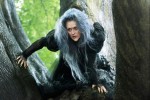In contrast to previous movie adaptations of musicals that favored big names over actual singing ability – see Russell Crowe’s performance as Javert in 2012’s “Les Misérables” – Disney’s “Into the Woods” provides a worthy adaptation of Stephen Sondheim and James Lapine’s musical and a strong ensemble cast that can carry the weight of Sondheim’s winning score.
The film follows a childless baker (James Corden) and his wife (Emily Blunt) as they try to lift a curse that makes his family tree a barren one. Under the blue witch’s (Meryl Streep) instructions, the two journey into the woods to seek a cow as white as milk, a cape as red as blood, hair as yellow as corn and a slipper as pure as gold.
Their quest leads them to encounter characters from other fairy tales that have the mentioned items, including Jack (Daniel Huttlestone) from “Jack and the Beanstalk,” Little Red Riding Hood (Lilla Crawford), Rapunzel (Mackenzie Mauzy) and Cinderella (Anna Kendrick).
This star-studded cast proves to be one of the film’s greatest strengths since the majority of the stars have experience performing in musicals. For example, Crawford and Huttlestone have starred in major stage musicals such as “Annie” and “Oliver!,” respectively, and Christine Baranski (who plays Cinderella’s wicked stepmother) and Corden both have Tony Awards under their belts.
But even Chris Pine as Prince Charming holds his own against the more experienced cast members. His rendition of “Agony” is goofy and harmonious, making for one of the more memorable numbers of the film.
Nevertheless, Pine’s performance cannot compare to those of Blunt and Streep, who steal the show. As the baker’s wife, Blunt is charismatic and funny and has great chemistry with Corden. Streep’s performance has attracted Oscar buzz from critics and rightly so; her singing and acting command the audience’s attention – a far cry from her awkward performance in 2008’s “Mamma Mia!”
Overall, “Into the Woods” transitions smoothly to the big screen, likely assisted by Lapine, who wrote the screenplay. Plus, director Rob Marshall, who took charge of the Academy Award-winning adaptation of “Chicago” in 2002, knows how to skillfully combine stage and film techniques.
The film was shot on location in the English countryside, and its lush landscapes help to contextualize the beloved fairy tales among the sloping hills and ancient castles. By not solely depending on sets or the green screen, Marshall took full advantage of his resources to set the film apart from the stage musical.
Although film offers greater special effect opportunities than the stage, “Into the Woods” did not employ as many effects as audiences may have expected. The effects mainly enhanced the magic of the witch or the magic beanstalks that climbed into the sky, in addition to the effects used to create the towering lady giant (Frances de la Tour) who descends from one such stalk, creating a more menacing opponent than the stage version.
The film delves into darker themes near the end and employs a surprising amount of off-screen violence for a Disney film – including a scene in which the wicked stepmother chops off parts of her daughters’ feet to fit into Cinderella’s shoe. Although Disney marketed the film for all ages, the film’s somewhat dystopian ending does not seem kid-friendly.
However for the most part, “Into the Woods” appeals to a wide range of ages, among the musical-loving audience. The film fits well into Disney’s recent interest in live-action remakes of fairy tales such as 2014’s “Maleficent” and “Cinderella” slated for this spring. And with a more by-the-book interpretation of the Grimm’s Fairy Tales, “Into the Woods” offers a refreshing change from Disney’s sickly sweet happily ever after.
– Savannah Tate
